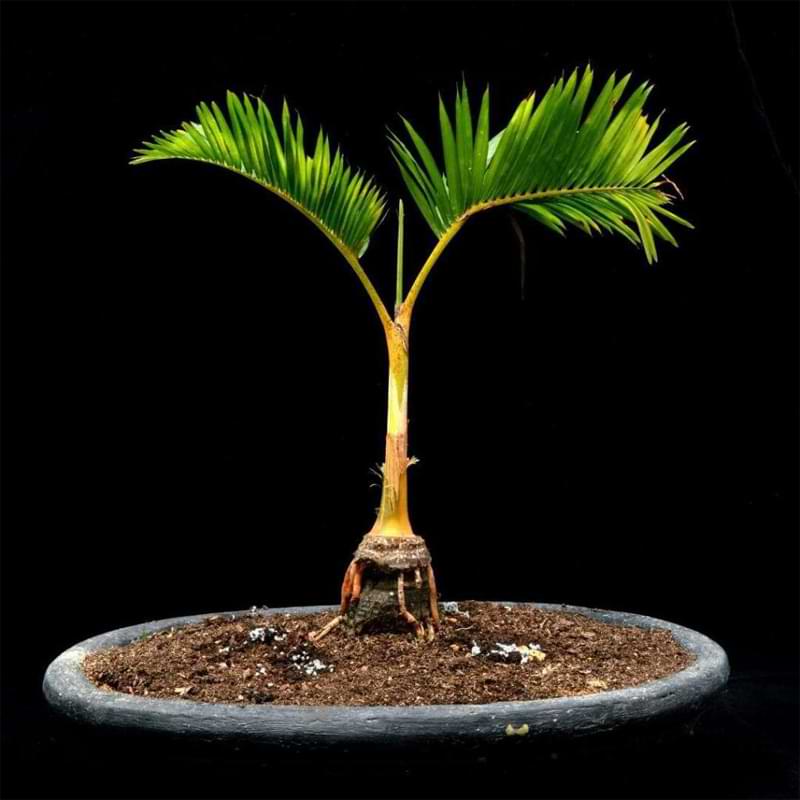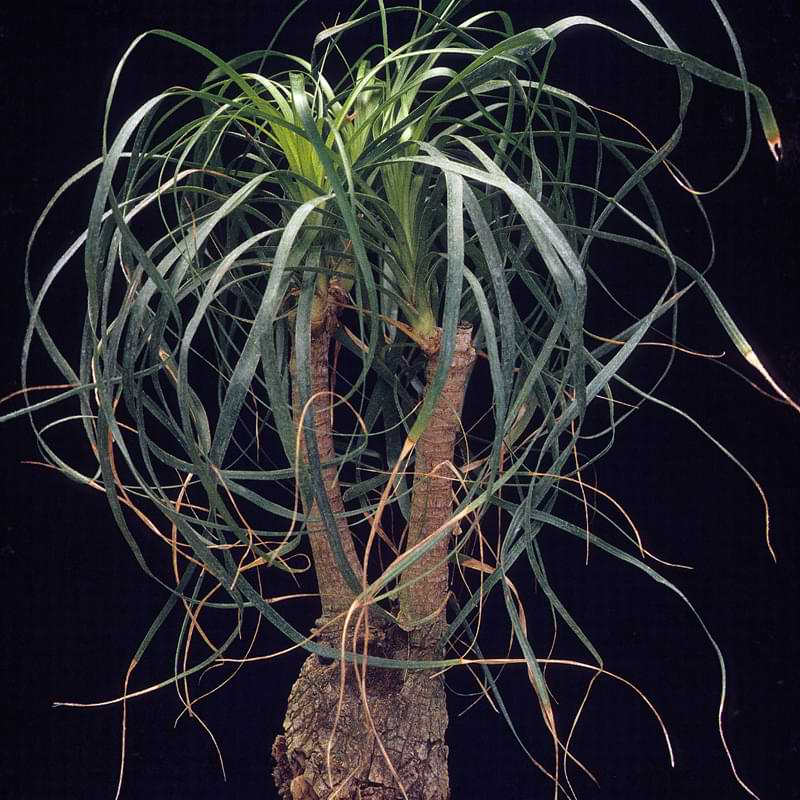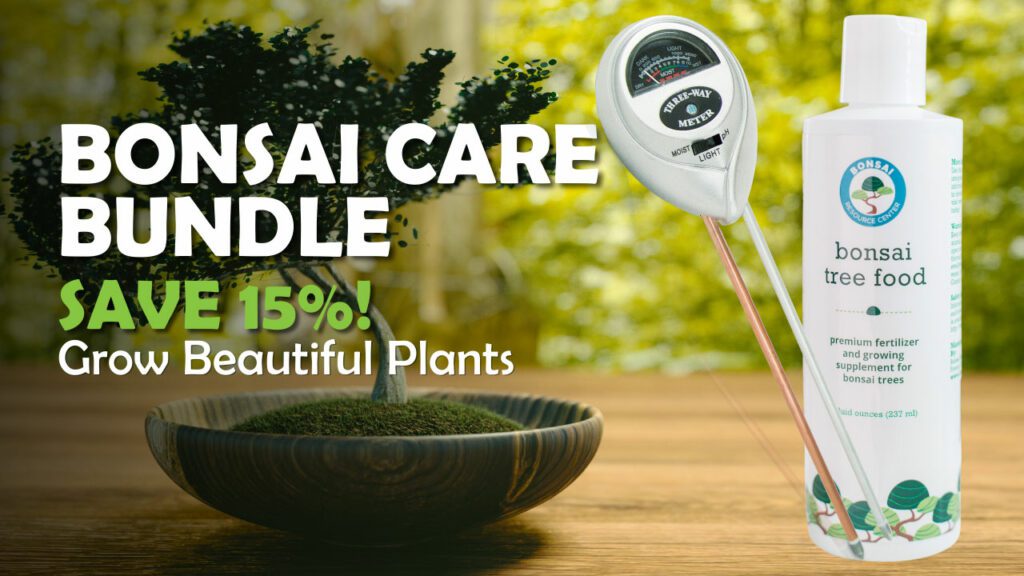Once you’ve been bitten by the bonsai bug, you’ll probably find yourself repeatedly wondering, “Could I bonsai THAT?” Luckily, the bonsai effect can be achieved with an extremely wide variety of trees, shrubs, and plants—so the answer is usually YES!
Rewatching Pocahontas? Yep! You can bonsai your own Grandmother Willow.
Hugging a giant sequoia tree? Redwood bonsai trees are a fun challenge!
Admiring palm fronds waving in the wind? Well…not so fast. Even bonsai has its limits.
Can Palm Trees Be Bonsai?
Unfortunately, the palm trees you’ll find on a beach vacation don’t grow well in bonsai form. That’s because creating a bonsai requires you to restrict growth above and below ground. Palm trees don’t have any branches to prune; and their massive root systems don’t take well to being trimmed or living in shallow containers.
But it’s not all bad news! If you’re set on bringing a slice of tropical paradise into your bonsai practice, you’ve got options. In this Guide to Bonsai Palm Tree Care we’ll take a look at two popular bonsai “palms” and how to keep them healthy and strong.
Two Types of Bonsai “Palm” Trees
When someone refers to a bonsai palm tree, they’re most likely talking about a ponytail palm or a sago palm bonsai. While neither species is technically a palm tree, they boast similar characteristics that contribute to their wide appeal. And unlike true palm trees, ponytail and sago bonsai are easy to grow!
Let’s take a closer look:
1. Ponytail Palm Bonsai
Native to southern Mexico, the ponytail palm is actually a member of the succulent family. Also known as a bottle palm or elephant’s foot, this hardy plant is an excellent beginner’s bonsai. Ponytail palms are known for their thick, bulbous trunks and wispy, cascading foliage (which resembles palm tree leaves). Ponytail palms are extremely low-maintenance plants that grow well indoors and bring tropical vibes to any space.
2. Sago Palm Bonsai
Another palm imposter, the sago palm has a pineapple-like trunk and rigid foliage that shoots up in a radial pattern. This ancient plant roamed with the dinosaurs, surviving the Earth’s many changes and challenges thanks to its extreme hardiness. Native to southern Japan, the sago palm is a very popular bonsai species and grows well in almost any condition.

Caring for a Ponytail Palm Bonsai
Placement
Ponytail palm bonsai are a very hardy plant, making them great for beginners or people with busy schedules. They’re a slow-growing, low-maintenance plant that is just as happy in a sunny garden as it is in your kitchen window.
- Lighting: Ponytail palms like bright, indirect light, but they’re not picky about whether that comes from the sun or an artificial source like a grow lamp. In the cooler months, however, your bonsai will go semi-dormant and should be placed somewhere where it doesn’t receive any sunlight.
- Temperature: Native to semi-desert regions in Mexico, it’s no surprise the ponytail bonsai palm tree likes warm weather. The best outdoor growing regions are USDA hardiness zones 9-12. While ponytail palms can survive temperatures that dip as low as the 20s, you’ll want to bring it inside once evenings regularly tiptoe into the 50s. At this point, it’s time to prepare for dormancy: let your plant ride out the winter months somewhere it can stay around a comfortable 50 degrees.
- Humidity: Like many desert plants-turned-houseplant, ponytail palms do well in dry, indoor environments. For the same reason, they’re also a little less tolerant of muggy outdoor heat. If you live somewhere hot and dry, your ponytail bonsai palm tree should do great outside (just be sure to introduce it slowly).
Watering
Like cacti, ponytail bonsai store water in their sturdy trunks, which means they rely less on bathtime than other plants. Drought-(and forgetfulness-)tolerant, your ponytail bonsai can go up to 4 weeks without water. Rather than sticking to a schedule, check soil moisture with your finger a few times a week. Once you feel the topsoil is bone-dry, give your plant a drink.
Fertilizer
Ponytail palm bonsai are hungry during the growing months! Once new growth appears, use a gentle liquid fertilizer every time you water. During the winter months, decrease your feedings to once every other month. Be wary: if you’ve recently repotted your plant, hold off on watering for about 6 weeks to avoid stressing out its vulnerable roots.
Pruning & Styling
Because ponytail palms are slow-growing and have no branches, they require very little pruning and zero wiring. To create the “ponytail” effect, use sharp, clean shears to cut off the leaf cluster at the top of the plant; this encourages it to sprout new foliage from its sides. Bonsai beware: Do not remove all foliage at once or new leaves will grow back aggressively and quickly.
When it comes to general pruning, remove browning or damaged leaves in a radial fashion. This is best done in the early summer to give your plant time to produce healthy new growth.

Caring for a Sago Palm Bonsai
Placement
The sago palms growing in the world today are largely unchanged from their ancient ancestors. Over several hundred million years, these extremely hardy plants have evolved to endure just about anything. But that doesn’t mean they don’t have preferences! Here’s how to provide the perfect lighting, temperature, and humidity for your bonsai palm tree:
- Lighting: While sago palms will do fine in a shadier spot, they’re happiest in full sunlight. For a healthy, attractive plant, provide at least 5 hours of full sun each day.
- Temperature: The tough sago palm can endure cooler late-season temps and most bright, hot summer days. But its Goldilocks zone is between 50 and 80 degrees Fahrenheit.
- Humidity: A prehistoric plant, the sago palm likes it humid! If you’re keeping yours indoors, avoid placing it next to fans, vents, or air conditioners, which can dry it out. (Misting the leaves can help boost moisture too!)
Watering
Even the hardiest plants have an Achilles’ heel; and for the sago palm, it’s overwatering. Unlike many bonsai, which prefer to be watered once the topsoil is dry, this plant would prefer you to wait until its root ball has had a chance to dry out. Prolonged overwatering can lead to root rot, which can be fatal if left untreated.
In the growing months, this usually means no more than one bath per week. In the dormant months, you’ll water even less frequently. A plant moisture meter can help you determine soil conditions near the root ball. Bonsai beware: When in doubt, wait it out. Sago palms fare better a little thirsty than a little waterlogged.
Fertilizer
The slow-growing sago palm does not need to be frequently fertilized. Feed once at the start of the growing season as new growth appears. Fertilize once more in the peak of midsummer, and again once temperatures begin to dip in the fall. Hold off on fertilizer altogether in the winter months, and resume as scheduled in the spring. Bonsai beware: As with watering, the sago palm can manage better when it’s slightly under-fertilized than when it’s overfed.
Pruning & Styling
Like the ponytail palm bonsai, sago palms do not require wiring or structural pruning. (No branches!) They will, however, need some standard pruning throughout the growing season. When it’s time for a trim, first remove any dead or damaged foliage using sterile shears. Then cut the oldest lower leaves as close to the trunk as you can. Cut any sucker or “puppy palm” sproutlets and discard or transplant into a new container.
Are Bonsai Palm Trees Toxic?
Both sago and ponytail palm make excellent, forgiving bonsai palm trees for new growers. But if you’re practicing bonsai with a furry roommate, beware: All parts of the sago palm are highly toxic to animals. Read our guide to fur-friendly bonsai to learn how to prevent a dangerous accident. Or get your palm tree bonsai fix with a ponytail palm instead! They’re designated non-toxic to animals by the ASPCA.
Don’t risk it: If you think your pet has ingested sago palm or any other toxic substance, contact your vet or pet poison control hotline immediately.
Have another question about caring for your bonsai palm? Join the conversation in our Facebook group.
Bonsai With Us!
The Bonsai Resource Center is here to help you learn about bonsai palm and provide you with the tools you need to keep your tree healthy and strong. Explore our other articles, visit our online shop, and connect with other bonsai lovers in our Facebook group to learn everything you need to know about this rewarding hobby!
More Bonsai Tree Resources
6 Easy Steps to Wire Bonsai Trees
Growers Guide: How to Make a Bonsai Tree



